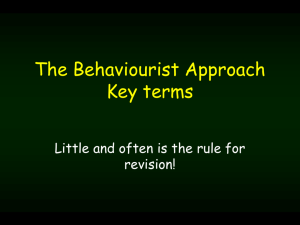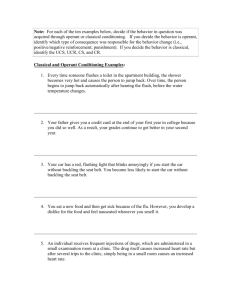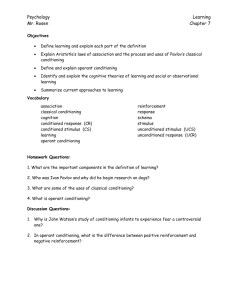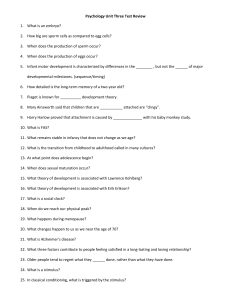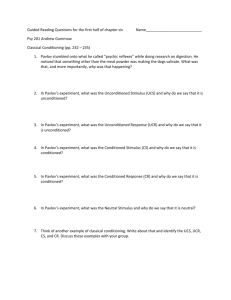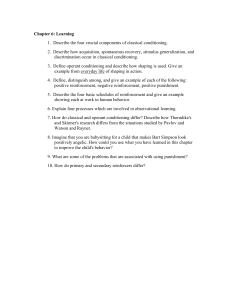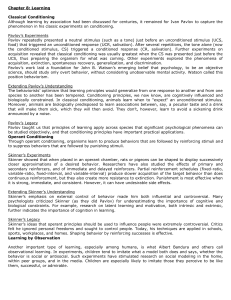The Behavioural and Social Cognitive approach
advertisement
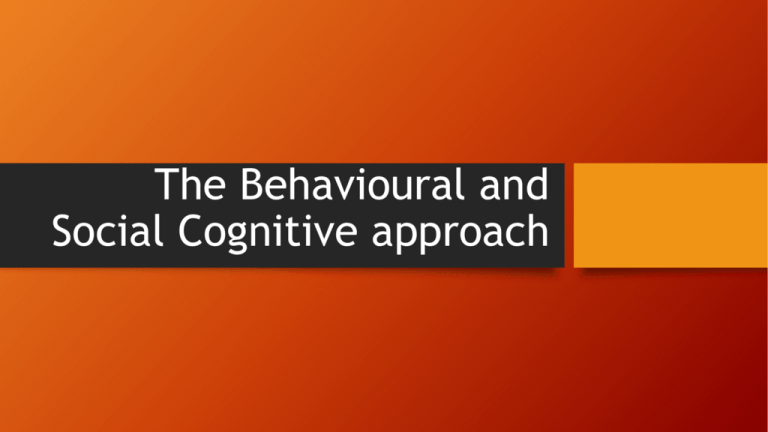
The Behavioural and Social Cognitive approach • Behaviourism – what can be directly observed and measured • The belief that development is observable behaviour that can be learned through experience with the environment • • • • • Continuity in development Not in stagelike fashion Pavlov’s classical conditioning Skinner’s operant conditioning Bandura’s social cognitive theory Ivan Pavlov • Handout – iceberg • He began to see that dogs salivate when they taste food. When there are certain sounds, even before eating they salivate • Example: ringing the bell to get food, ringing the bell later – even if they don’t get food they associate that sound with food • 1920’s John Watson demonstrated Pavlov’s concept of classical conditioning could be applied to humans • VIDEO(SEE CLASSICAL CONDITIONING – IVAN PAVLOV) • You might recognize the guy in the video as Philip Zimbardo (Stanford prison experiment) • Classical conditioning is when you have a neutral stimulus (like ringing the bell) to produce another stimulus (food) John Watson’s demonstration • Albert experiment – showed albert a white rat to see if he was afraid, he was not. A loud noise was sounded and it caused albert to cry. After only several pairings with the loud noise, Albert began to fear the rat even when the noise was not sounded • Albert had been classically conditioned to fear the rat • The experiment would probably be seen as unethical today • VIDEO Classical Conditioning formula • See if you can apply Pavlov’s formula to little Albert’s experiment Apply Pavlov’s Classical conditioning formula • Original Stimulus (loud noise) = Desired response (fear/ crying) • Original stimulus (loud noise) + Neutral stimulus (rat) = Desired response (fear/crying) • Neutral stimulus (rat) = Desired response (fear/crying) • So what Pavlov and Watson argued is that we are conditioned to fear and be scared of things at a young age • We are classically conditioned to fear • Does the pairing of ethnic groups or gender with specific behaviours lead to stereotypes B.F. Skinner Operant Conditioning Skinner’s Operant Conditioning • Classical conditioning may explain how we develop involuntary responses such as fear, but B.F. Skinner argued that a second time of conditioning accounts for the development of types of behaviour. • Operant conditioning – the consequences of a behaviour produce changes in the probability of the behaviours future occurrence. If a behaviour is followed by a rewarding stimulus, it is more likely to recur. But if a behaviour is followed by a punishing stimulus, it is less likely to occur • Example: when a person smiles at a child after the child has done something, child is more likely to engage in that activity than if the person gives the child a nasty look Formula • On your iceberg handout • Behaviour + rewarding stimulus = reoccurrence • Behaviour + punishing stimulus = no reoccurrence • Can you think of your own examples here? • Skinner thought that rewards and punishments shape individuals’ development • Example: a shy person learned to be shy because of the environmental experiences they had while growing up • Modifications to an environment can help a shy person become more socially oriented. • Behavioural changes are brought about by rewards and punishments, not by thoughts and feelings. • Bird video • Big bang video • Penny knows that she will get chocolate if she does something good. So she continues to do something good to get that chocolate. Operant Conditioning - Closure Issue (Big Bang Theory) https://www.youtube.com/watch?v=rZi92OEbaqs Your turn • Operant Conditioning Practicum Experiment (Handout) Albert Bandura Turn to page 52-53 • Read on your own and take notes • Behavioural and social cognitive approach – view of psychologists who emphasize behaviour, environment, and cognition as the key factors in development • Albert Bandura and Walter Mischel are the main architects of social cognitive theory’s contemporary version • Bandura’s early research focused on observational learning (learning that occurs through observing what others do – also known as imitation or modelling) • Bandura believes that people cognitively represent the behaviour of others and then sometimes adopt this behaviour themselves • Example: parents who tell their kids they have 3 options – a, b, or c may hear their child resolve a conflict with a friend saying the same thing • The belief that people acquire behaviours, thoughts, and feelings through observing others’ behaviour • Important part of life-span development Most recently Bandura said there are 3 elements… • Behaviour • The person – individual’s confidence that he or she can control his or her success • The environment • Each element can change the person’s cognition The example used… • College student’s achievement behaviour Your turn… • In groups of 3-4, complete the “Applying Banudra’s Theory” handout Examples • https://www.youtube.com/watch?v=S4N5J9jFW5U • https://www.youtube.com/watch?v=PsTlJyox0Kg – Bobo doll experiment
